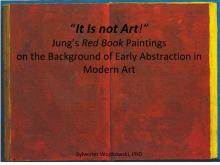Submitted by ARASAllison on
 That which belongs to the spirit of the future can only be realized in feeling, and to this feeling the talent of the artist is the only road. Wassily Kandinsky, Concerning The Spiritual In Art (1913),12
That which belongs to the spirit of the future can only be realized in feeling, and to this feeling the talent of the artist is the only road. Wassily Kandinsky, Concerning The Spiritual In Art (1913),12
Therein lies the social significance of art: it is constantly at work educating the spirit of the age, conjuring up the forms in which the age is most lacking. C. G. Jung, CW 15, p. 82
I can understand modern works of art only as idols from the underworld, and they become accessible to me only through a knowledge of the psychology of the unconscious. They do not affect me aesthetically. It may very well be that my attitude is that of a Philistine, but God knows I can't find them beautiful. Perhaps other centuries will, in which case I am thankful to the Creator that man doesn't live for 200 years, otherwise he would suddenly find himself in an age in which he would choke to death. C.G. Jung’s Letter to Hans Welti 12/23/1932, L1
We can therefore attribute to modern art a conscious or unconscious intention to turn the beholder's eyes away from the intelligible and enjoyable world of the senses and to enforce a revelation of the unconscious as a kind of substitute for the loss of human surroundings. C.G.Jung, CW10 ¶ 754
Contemplation of an abstract painting always starts me off on the following train of thought: it is not an object of experience in the outer world, nor is it meant to be. If nevertheless there are hints of something recognizable, this is an unintentional lapse or an unavoidable concession to the understanding of the beholder, or to a desire to communicate. 10/21/60 C.G. Jung’s Letter to the Swiss Painter Rene A. Kipfer, L2, 604-5
IT IS NOT ART
In the first part of this paper I will present a visual amplification of Jung’s Red Book paintings, juxtaposing them with works of modern abstract art. I ask the reader/viewer to make his/her own judgment of how similar or different are his works from the representative works of abstract artists, his contemporaries, and draw their own conclusions.
In the second part I will discuss Jung’s attitude towards modern art.
In the third part I will present a selection from the artwork and writings of spiritual abstract artists that reflect on their understanding of their work. Their elucidation of their process resonates with Jung’s understanding of the psyche.